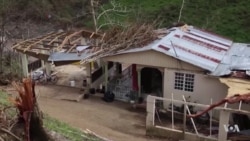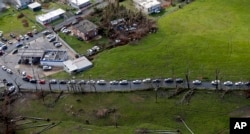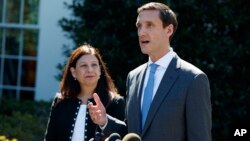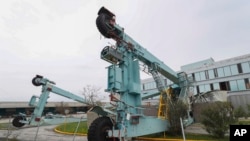White House officials say a federal force of 10,000 people, including 7,000 troops, are helping Puerto Rico dig out of the devastation left by Hurricane Maria.
The U.S. Navy ship Comfort, a 1,000-bed hospital ship based in the U.S. state of Virginia, is scheduled to depart the U.S. mainland for the island Friday. Homeland Security Adviser Tom Bossert said Puerto Rico has 44 operational hospitals out of a total of 69 facilities.
The Pentagon has appointed Lt. Gen. Jeffrey Buchanan to lead all military hurricane response efforts in Puerto Rico, a U.S. territory.
WATCH: US Officials Say Damaged Infrastructure Slows Aid Distribution in Puerto Rico
Critics: Help too slow
Critics have accused the Trump administration of not responding more quickly to the disaster in the wake of the hurricane, which ravaged Puerto Rico on Sept. 17, taking out buildings, knocking out communications, and nearly destroying the island’s aging power grid.
On Thursday, Bossert defended the eight-day period between the declaration of an emergency in Puerto Rico and the naming of a leader for recovery efforts.
“It didn’t require a three-star general eight days ago,” he told reporters at a White House news briefing. Bossert also said some of the information he has heard on the news has been out of date.
“The coverage in some cases is giving the appearance that we are not moving fast enough,” he said.
Bigger, tougher than Katrina
Russel Honore, highly lauded for commanding the military response after another big storm, Hurricane Katrina in 2005, said the military deployments to Puerto Rico are at least four days too late.
Honore told National Public Radio that because of its distance from the mainland and the loss of its power grid, Puerto Rico “is a bigger and tougher mission than Katrina.”
Stung by the criticism, administration officials have emphasized the complexity of delivering aid to the storm-ravaged territory.
“This is an insular island, a territory that stands some distance from the United States,” Bossert, the Homeland Security adviser, said.
“The constraints and limitations are different from a contiguous state here in the United States. We can position hundreds of trucks in Florida or Texas for restoration of line services. We can’t do that in Puerto Rico.”
Bossert also said, “The president and I have absolute, 100 percent confidence in what Secretary [Elaine] Duke, [FEMA Director] Brock Long, and the men and women of Puerto Rico are doing. They are going to get through this.”
On Thursday, Duke said the relief effort in Puerto Rico is “under control” and told White House reporters that Puerto Rico “is really a good news story, in terms of our ability to reach people.”
Ships, trucks needed
FEMA regional administrator John Rabin told reporters Thursday that the U.S. government has so far delivered 1.1 million liters of water and about 1 million meals to the island of 3.5 million.
But he added that ships, not planes, are needed to get more supplies to the island.
“The only way we are going to get significant amounts of water and food is through ports and through barges and shipping,” he said. “You can’t get enough through the aircraft.”
He said officials are “very focused” on getting supplies from the ports to the distribution centers.
Army Brigadier General Richard Kim told reporters there are 4,400 Defense Department personnel in Puerto Rico, including Puerto Rican National Guard members.
Earlier Thursday, the Trump administration suspended a law that had been hampering delivery of desperately needed aid to hurricane victims, while House Speaker Paul Ryan said the Federal Emergency Management Agency’s disaster relief account would receive an additional $6.7 billion boost within days.










